#Young Madhubala
Explore tagged Tumblr posts
Text


Ronald Colman and Loretta Young (Bulldog Drummond Strikes Back, Devil to Pay, Clive of India)—I can't send you links in asks or I'd include a photo. D': D': I have several! D':
Madhubala and Dilip Kumar (Tarana, Sangdil, Mahal, Devdas, Naya Duar)—no propaganda submitted
This is round 1 of a mini Christmas tournament. Each poll lasts for three days. If you'd like to send additional propaganda supporting your favorite hot couple, you can reblog this post with your propaganda added, send it to my asks, or tag me in it. To vote in all the polls, click here. Happy holidays!
[additional sexy propaganda under the cut]
No additional propaganda submitted for Colman and Young.
Madhubala and Dilip Kumar:

84 notes
·
View notes
Text
Being Queer and Finding Love

As an amab (male) queer who is attracted to women more than men, I somehow relate to this (the above meme). It's frustrating and deeply depressing.
Ashutosh | 31st October 2024
It gets fucking lonely. I can't be queer and also flirt with a woman I'm attracted to, because then she just might think I'm that "gay friend" she can go shopping with (as much as I love shopping, myself), and whom she can set other men up with. It literally robs me of my own queer experience!
Love is an impractical dream if I want to just be myself, viz, if I'm not overtly masculine (but simply queer, non-binary)— and I don't like being masculine all the time! It's exhausting! As proud as I am of my queer identity and even to wear it around, I am also afraid to reveal it (in this case, to women I feel romantically for). Love has always been so far out of my reach—or, perhaps always only a touch out of view—that it justifies my loneliness, which in turn, justifies my constant desperation for love when I seek it out. My identity as "queer" is often co-opted, and I am reduced to a sidekick, my attempts at flirting (or, in better words, at courting love) dismissed as merely platonic actions.
Pardon the apparent "paranoia," for it actually isn't. It is an anxiety. And it is born from an apparent pressure— an unnatural pressure to 'act' overtly masculine, to mask my true self from the love I want to court. Love then feels like deception, and there is nothing I hate more than deception, the sheer insincerity subsumed in it. I don't feel free to love sincerely, honestly. And that pressure is external to me.
As a result, I often have to choose between being queer and finding love. Love can be found anywhere, not just on dating apps. But lately, in the real world, access to love is socially regimented in time, space, and methodologies, constructs which I recognise but do not intuitively understand. Outside of the realm of dating apps, and the meaningless hookups and superficial dates (romantic meet-ups) that reek of reluctance/avoidance that follow, finding love organically is an awkward game of chess. When I fail to make my move, I tell myself and others that I am shy—maybe I am—but really, I am terrified. And the game of love is so scary, that being queer feels easier, even if it isn't complete, even if I am incomplete. At least I exist, even if it's in the friend-zone. At least people are being "nice" to me. At least it "feels" like I have friends. At least this, at least that.
And when did love become a game of absolutes where there are winners and losers, success and failure, fuckables and unfuckables, sigmas and simps, alphas, betas, romeos, creeps, chads and charlies?
I was born to love. But love feels like an unfulfilled promise, and so do I.
Fin.
Post scriptum:
It physically hurt as I wrote this, because even I only realised this just now. Now I have to come to terms with it. This is my reality.
I can still feel a weird "surge" in my chest... Some kind of "welling up" in my chest cavity... Reminds me of SRK's film, "My Name is Khan."
Here are some songs that compliment this blog post...
Lyrics that hit home:
Kishore Kumar
Yeh dariya, yeh mauji, yeh sahil,
Yeh chhalki huyi mastiyaan
Hain aati nazar, kuchh kami si magar...
Jaane kya yeh nila aasmaan...
Kya khabar, kya patah... ja raha hun main kahan...?
Akela hun main is jahaan mein,
Akeli meri daastaan,
Nah manzil koi, nah saathi koi...
Jaane kya ye nila aasmaan...
Kya khabar, kya pata... ja raha hun main kahaan...?
This stanza is from a song Kishore Kumar composed himself. It is from his shelved film, "Neela Aasman," with Madhubala... it was shelved after her tragic death. Kishore Kumar wrote many of his songs himself; some of his songs were actually poems which he wrote as a young student. Jhumroo is one example.
Every time I listen to Kishore Kumar, I somehow feel like I have known him personally. I relate with him very deeply emotionally.
Beyond his known flaws, and the obviously charismatic jolly-good-fellow personality that is reflected in his popular songs and films, some of his poetry and music reflect a part of his personality which seems, however, forgotten. Apparently, he was a very deeply emotional man, and some of his very rare songs reflect his loneliness and almost hopeless yearning for true love, while songs like Jhumroo, which reflected hope, resilience, and perseverance, compensated for such depressing finalities.
Imagine Dragons—
I'm a reckless mistake,
I'm a cold night's intake,
I'm a one night too long,
I'm a come on too strong.
All my life I've been living in the fast lane,
Can't slow down, I'm a rollin' freight train.
One more time,
Gotta start all over,
Can't slow down,
I'm a lone red rover.
I'm a hold my cards close,
I'mma wreck what I love most,
I'm a first class let down,
I'm a shut up sit down.
I am a head case,
I am the color of boom
That's never arriving,
And you are the pay raise,
Always a touch out of view...
And I am the color of boom...
Oh! How did it come to this? Oh!
Love is a polaroid,
Better in picture,
But never can fill the void...
I'm gonna get ready
For the rain to pour heavy,
Oh, let it fall,
Let it fall upon my head.
Need I explain?
*****
#Queer#anthropology#love#lesbian#bisexual#pansexual#nonbinary#masculinity#lgbtq#lgbtqia#queer community#experience#lonelihood#loneliness#gay#romance#pride#music#songs#kishore kumar#imagine dragons#old hindi songs#old songs#bollywood#old bollywood#hindi cinema
5 notes
·
View notes
Text
THE 100 GREATEST SCREEN-PAIRS IN HISTORY OF WORLD CINEMA (@INDIES)!
.RAJESH KHANNA - MUMTAZ
.WALTER PIDGEON – GREER GARSON
.HUMPHREY BOGART – INGRID BERGMAN
.RICHARD BURTON – ELIZABETH TAYLOR
.ETHAN HAWKE – JULIE DELPY
.CHARLES CHAPLIN – EDNA PURVIANCE
.HUGH GRANT – JULIA ROBERTS
.KEANU REEVES – CARRIE-ANN MOSS
.RICHARD GERE - JULIA ROBERTS
.REX HARRISON – AUDREY HEPBURN
.CHARLES FARRELL – JANET GAYNOR
.CLARK GABLE – VIVIEN LEIGH
.UTTAM KUMAR – SUCHITRA SEN
.ROBERT REDFORD – BARBRA STREISAND
.DEV ANAND – WAHEEDA REHMAN
.CARY GRANT – INGRID BERGMAN
.KEANU REEVES – SANDRA BULLOCK
.GARY COOPER – INGRID BERGMAN
.JOSEPH FIENNES – GWYNETH PALTROW
.CHARLES BOYER – INGRID BERGMAN
.CARY GRANT – KATHERINE HEPBURN
.GURU DUTT – WAHEEDA REHMAN
.RAJESH KHANNA - TANUJA
.DILIP KUMAR - MADHUBALA
.TOM HANKS – MEG RYAN
.RAJESH KHANNA – SHARMILA TAGORE
.HUGH GRANT – RENEE ZELLWEGER
.SPENCOR TRACY – KATHERINE HEPBURN
.AMITABH BACHCHAN – PARVEEN BABI
.MICHEL PICCOLI – ROMY SCHNEIDER
.WOODY ALLEN – DIANE KEATON
.RAJESH KHANNA – REKHA
.MICHAEL DOUGLAS – GLENN CLOSE
.ALAIN DELON – ROMY SCHNEIDER
.ROD STEIGER – ROMY SCHNEIDER
.SHAMMI KAPOOR – ASHA PAREKH
.MARCELO MASTROIANNI – ROMY SCHNEIDER
.YVES MONTAND – SIMONE SIGNORET
.ALAIN DELON – ANNIE GIRARDOT
.JOHNNY DEPP – JULIETTE BINOCHE
.LAURENCE OLIVIER – VIVIEN LEIGH
.CLARK GABLE – JOAN CRAWFORD
.TREVOR HOWARD – CELIA JOHNSON
.PATRICK SWAYZE – JENNIFER GREY
.PREM NAZIR - SHEELA
.VINCENT CASSEL – MONICA BELLUCCI
.CLARK GABLE – AVA GARDNER
.JEAN-LOUIS TRINTIGNANT – ROMY SCHNEIDER
.JACK LEMMON – SHIRLEY MACLAINE
.HEATH LEDGER - JULIA STILES
.ANTHONY PERKINS – INGRID BERGMAN
.TOBEY MAGUIRE – KIRSTEN DUNST
.GREGORY PECK – AUDREY HEPBURN
.TOM CRUISE – RENEE ZELLWEGER
.AMITABH BACHCHAN - REKHA
.JAMES STEWART – MARGARET SULLAVAN
.RYAN GOSLING – RACHEL MCADAMS
.PRADEEP KUMAR – MEENA KUMARI
.ROBERT MONTGOMERY – ROSALIND RUSSELL
.JOHNNY DEPP – HELENA BONHAM CARTER
.BOBBY VERNON – GLORIA SWANSON
.DOUGLAS FAIRBANKS JR. – LORETTA YOUNG
.CLARK GABLE – CLAUDETTE COLBERT
.RAJESH KHANNA – ZEENAT AMAN
.GLENN FORD – GERALDINE PAGE
.LEONARDO DI CAPRIO – KATE WINSLET
.RAJESH KHANNA – ASHA PAREKH
.MEL GIBSON – CATHERINE MCCORMACK
.RAJ KAPOOR - NARGIS
.BRAD PITT – ANGELINA JOLIE
.CHRISTOPHER REEVE – MARGOT KIDDER
.CARY GRANT – SOPHIA LOREN
.SOUMITRA CHATTERJEE – MADHABI MUKHERJEE
.HUMPHREY BOGART – AUDREY HEPBURN
.SALMAN KHAN – AISHWARYA RAI
.ANTONIA BANDERAS – CATHERINE ZETA JONES
.RYAN O’ NEAL – BARBRA STREISAND
.JOHNNY DEPP – GWYNETH PALTROW
.MICHAEL DOUGLAS – KATHLEEN TURNER
.JAMES STEWART – CLAUDETTE COLBERT
.LAURENT MALET – ANNIE GIRARDOT
.DICK POWELL – OLIVIA DE HAVILLAND
.TOMMY STEELE – GERALDINE PAGE
.GEORGE BRENT – OLIVIA DE HAVILLAND
.MAURICE RONET – BRIGITTE BARDOT
.RAJESH KHANNA - SRIDEVI
.WILLIAM POWELL – MYRNA LOY
.ANTHONY PERKINS – ROMY SCHNEIDER
.MICKEY ROONEY – JUDY GARLAND
.RAJESH KHANNA - RAAKHEE
.SHAH RUKH KHAN - KAJOL
.RAAJ KUMAR – MEENA KUMARI
.MAHIPAL – ANITA GUHA
.RALPH FIENNES – JULIETTE BINOCHE
.ERROL FLYNN – OLIVIA DE HAVILLAND
.JOHN BOLES – BARBARA STANWYCK
.DHARMENDRA – MEENA KUMARI
.PETER FINCH – AUDREY HEPBURN
.MARLON BRANDO – KIM HUNTER
.MAURICE RONET – ROMY SCHNEIDER .
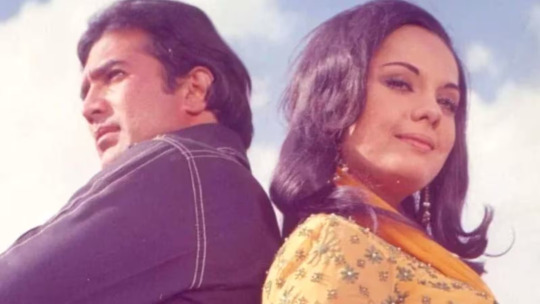


(P.S. - THE 2 PEOPLE WITH MOST ENTRIES IN THIS LIST, ARE-
RAJESH KHANNA OF INDIA WITH 8 ENTRIES, FOLLOWED BY ROMY SCHNEIDER OF AUSTRIA/FRANCE WITH 7 ENTRIES!)
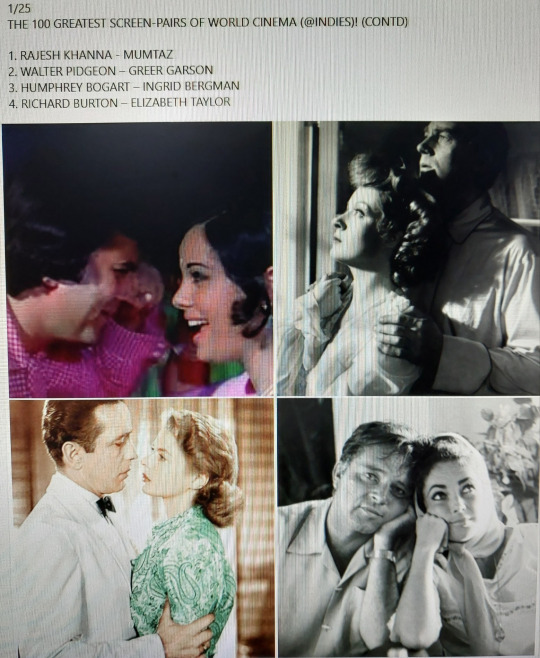
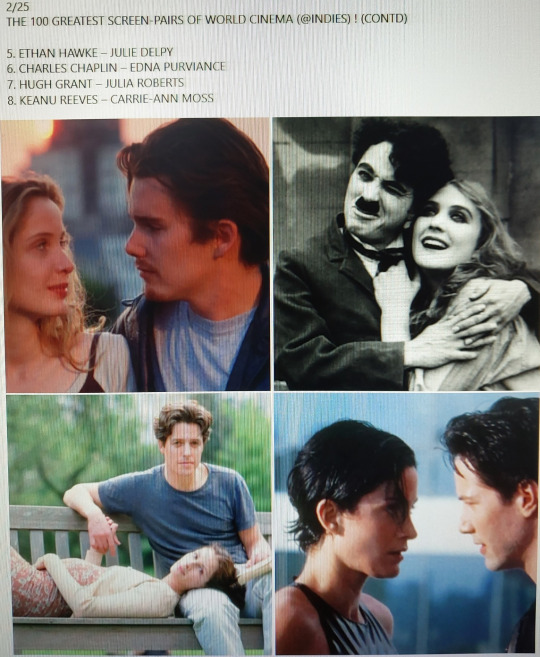

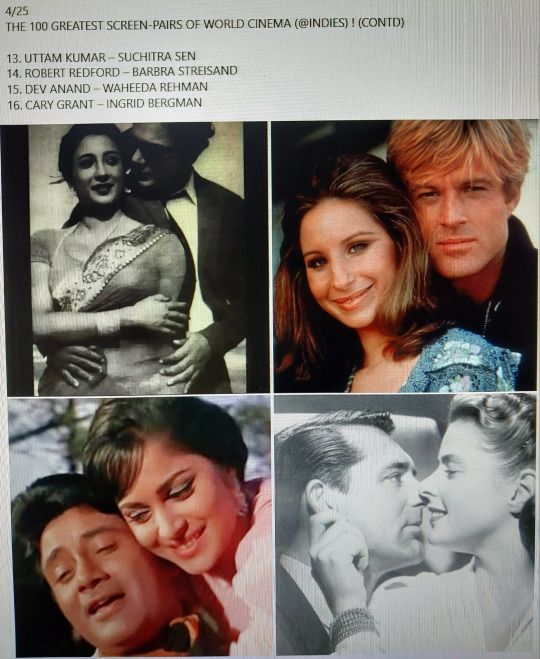
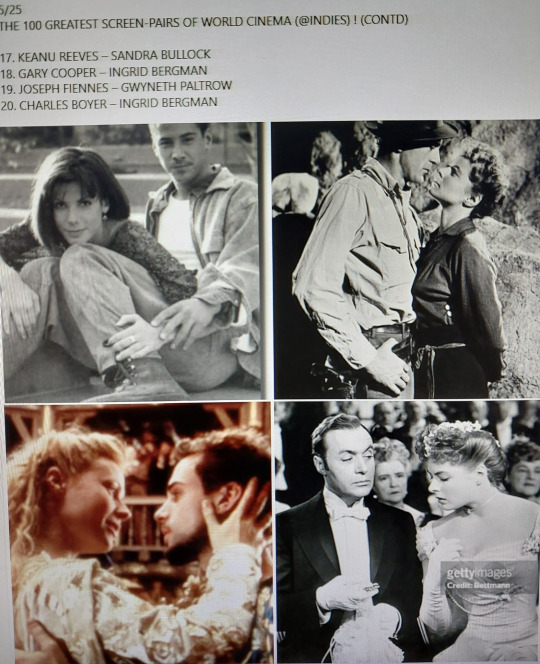
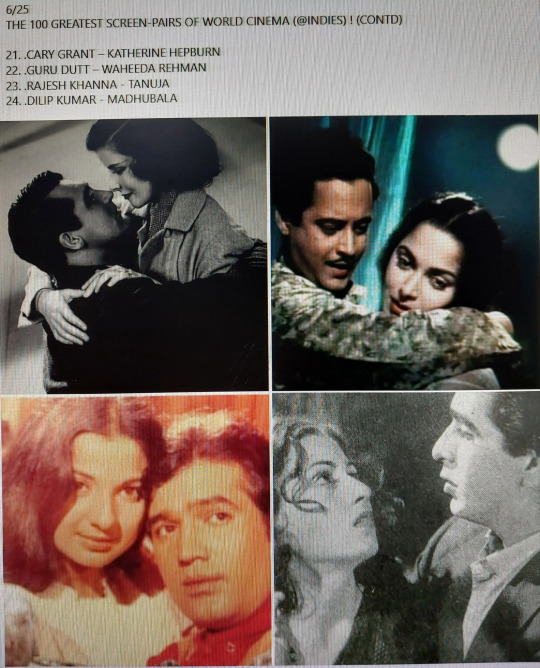
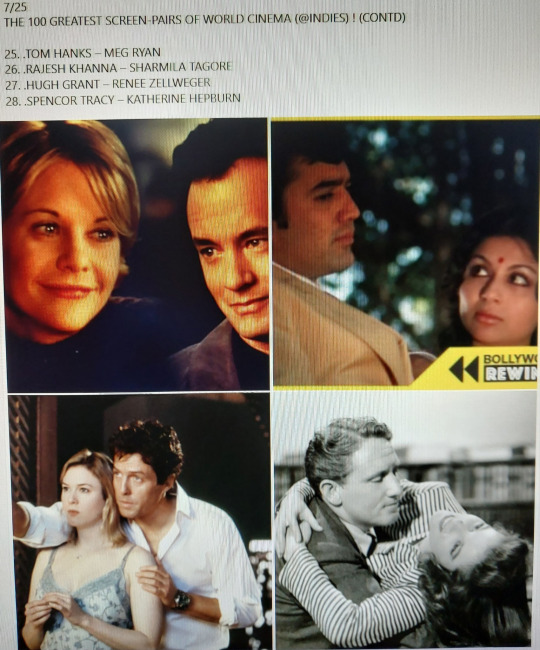
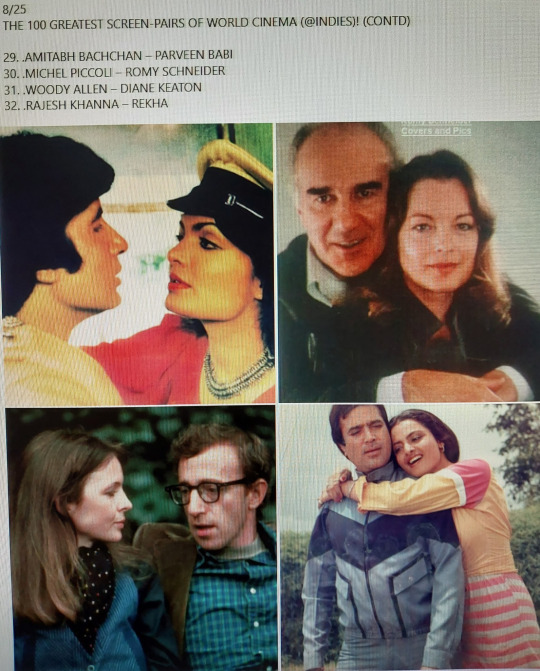
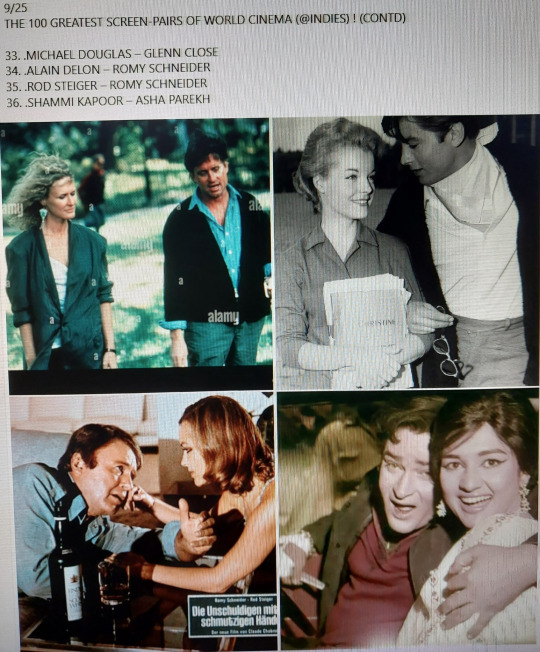

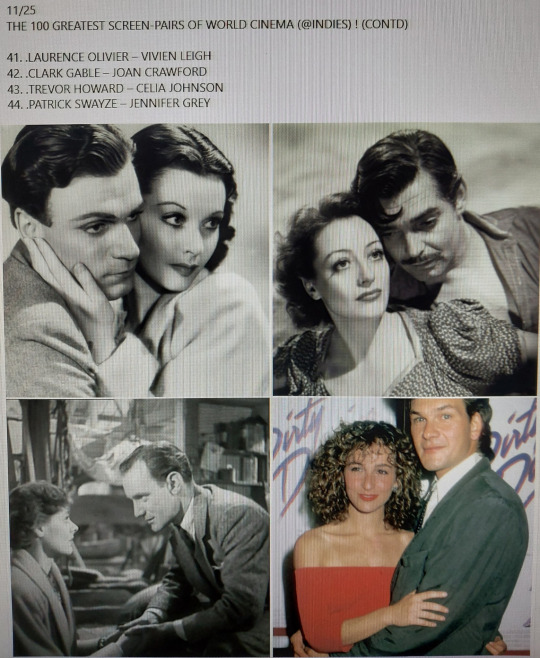


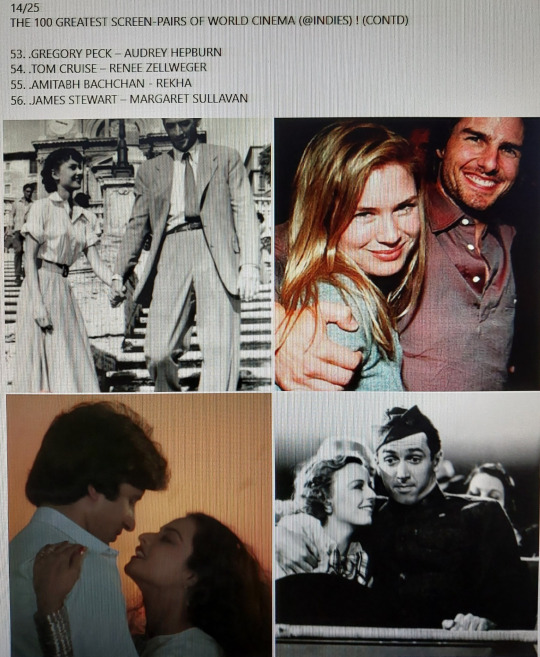


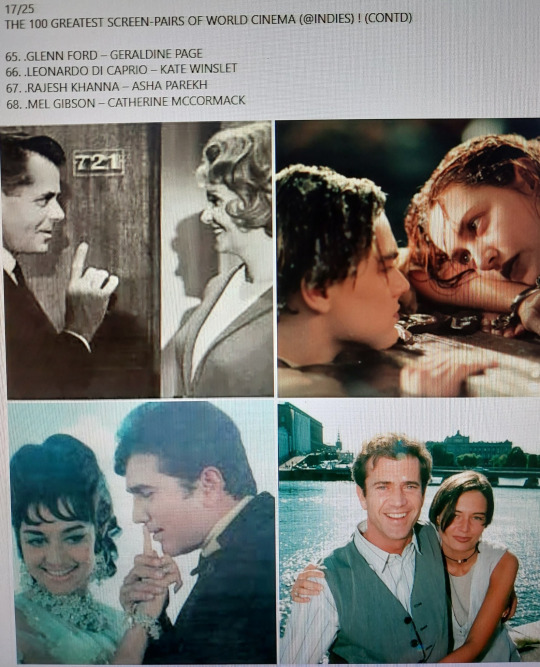
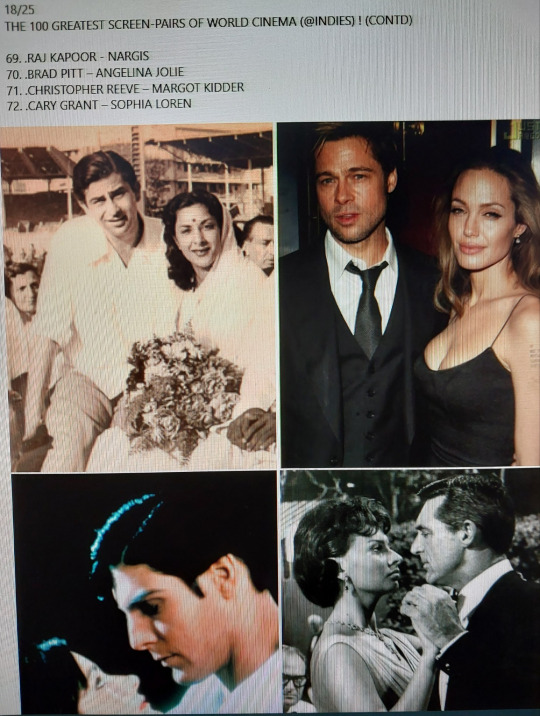
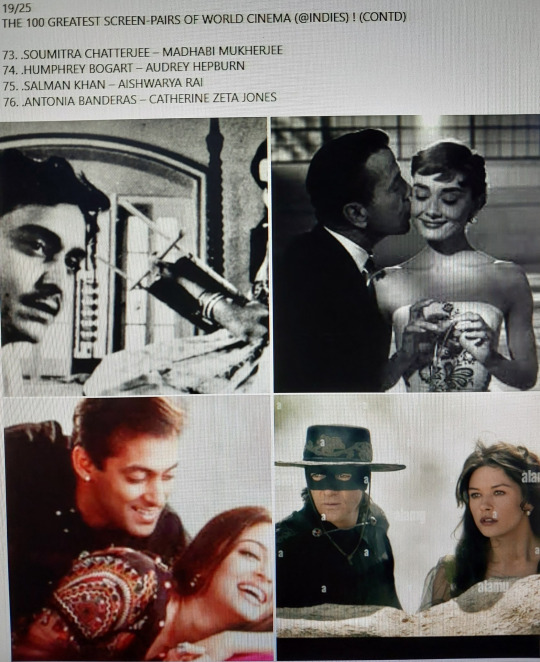

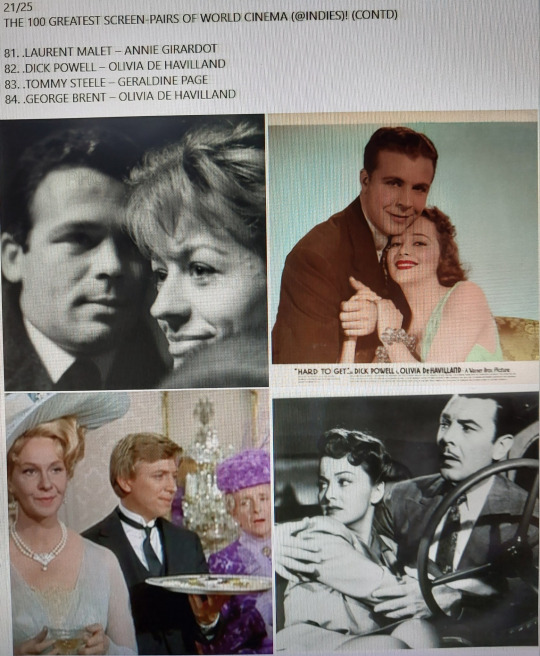

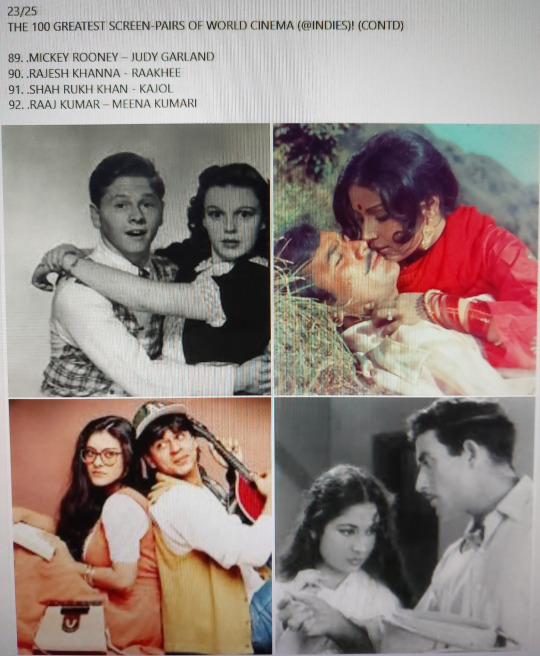

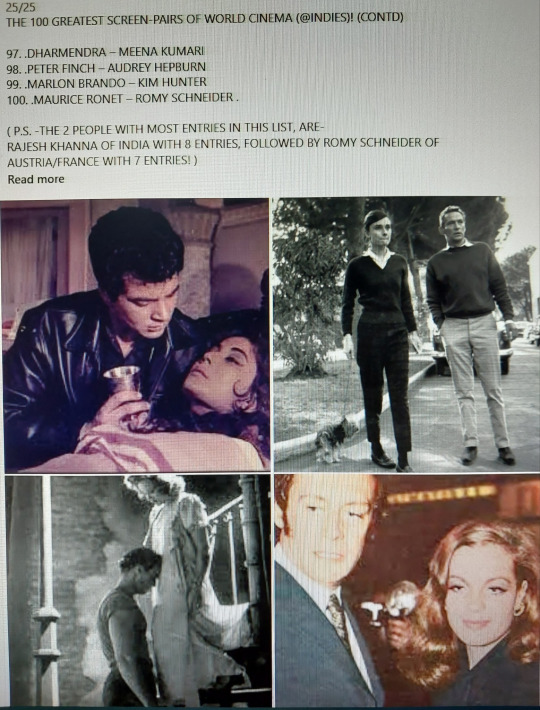
2 notes
·
View notes
Text
Evolution of Women Fashion in India
Every woman has an innate desire to look good and be appreciated for what she wears and how gracefully she carries herself. Indian women have primarily groomed themselves throughout various fashion cultures. From bell-bottoms to the classic salwar kameez, and from high-street shoes to bold chokers; Indian fashion for women has undergone a significant transformation over the last few decades.
The begging
The Indus Valley Civilization is where it all seems to have started. Records of some of the very first traditional Indian clothing were found during the Indus Valley Civilization (AKA the Bronze Age of Civilization) that lasted from 3300 BCE to 1300 BCE.
In 1950’s the fashion was modest, understated and formal. Men mostly wore dhoti-kurta, while women wore simple ghagra-choli. Movies shot in rural areas also had the same clothing scheme. However, the elite classes were more inspired by European fashion- dapper suits for men and elegant sarees for women. Puff sleeves were trendy and hair worn in graceful buns, with pearl becoming a staple piece of jewellery.
Fashion for both men and women varied based on class.
The 60s era
The 1960s was the decade that brought us Madhubala’s Anarkali suit and the tiered orange saree on Mumtaz. Moving into a new decade, women’s clothing became more fashionable and everyone embraced bright colours and prints.
With body-hugging churidar suits, shorter blouses and a hint of skin on display, the ‘60s were also big on embracing curves. Not to forget, the poufy hairdos, winged eyeliner and the uber-popular Sadhna cut were also from this decade.

The 80s era
This era was characterized by expansion of Fashion schools in India which was tagged by an outbreak alteration to Fashion in Indian clothing. It also marked the entrance of women in the workforce at a huge pace. The 80s brought the advent of Disco with an introduction to some shimmery and glittery costumes, denim and leather biker jackets, and chiffon sarees in varied colors with a fusion of Indian and western clothing styles. The 1980s also marked the active participation of women in the Indian Fashion Industry and altering Indian attitudes towards multiculturalism.

The 90s era
Fashion in the 1990s was defined by a return to minimalist fashion. The 90s marked the arrival of full-sleeve salwar kameez, floral dresses, long skirts, denim, shades, and dungarees. The decades following the 90s are touted to be the era when Indians adopted more westernized concept in the fashion making bold and stylish choices.

2000s to current era
Fashion during 21 st century brought revolution in trends. Today, one can find women in the urban areas dressing up in modern Indian clothes by Indian brands. The modern young woman still has space for her heirloom Kanjeevaram or Benaras sarees and other handlooms for those special occasions. The Indian woman is carving out a niche for herself in the world of fashion. It is safe to say that Indian fashion is weaving together international inspiration with traditional sensibilities. Dresses, tunics, pants and skirts made from Ikat, Khadi, silk and Chanderi fabrics and thread work are a rage among the modern women today.[1]

Conclusion
The evolution of Indian women’s fashion reflects a tapestry of cultural shifts, from traditional opulence to contemporary minimalism. As India embraces both heritage and innovation, women’s fashion will likely continue to reflect the dynamic essence of a society that values its roots while moving forward. Whether it’s through a beautifully draped saree or a chic Indo-Western ensemble, Indian fashion will always be a celebration of diversity, grace, and resilience.
.
.
.
.
.
1 note
·
View note
Text
Must-watch Bollywood Movies for Someone New to Indian Cinema
Indian Cinema has given some of the classics movies various genres and today I will talk about of the must-watch Bollywood movies for someone new to Indian cinema these movies are cult classics and a must-watch for early 20s age and young lads.

1. Sholay- A 1975 movie that needs no introduction and all we watching grown up to. Sholay is not just movie it is a nostalgia that makes Sholay a must-watch Bollywood movies for someone new to Indian cinema. A movie filled with great scenes and iconic characters still fresh in our minds even today that makes Sholay an emotion considering the success the movie was released in 3D version in 2012.2. Dilwale Dulhania Le Jayenge - When comes to Indian loves stories DDLJ is a movie that has redefined love stories is Bollywood. Characters of Raj and Simran played by Shah Rukh Khan and Kajol is still fresh in our minds. The nostalgia with the movie must-watch Bollywood movies for someone new to Indian cinema
3. 3 Idiots- 3 Idiots is a movie that have special in every student heart A 2009 movie treated as cult classic in Bollywood. A Movie that looks a classic even after 15 years of its released. 3 Idiots is probably is best movie of Amir Khan. There hardy any student who seen this movie.4. Lagaan- Another Amir Khan’s movie that is a must-watch Bollywood movies for someone new to Indian cinema a 2001 release based on a concept of underdogs becoming heroes. Lagaan was also an official entry to Oscars. The movie will celebrate its silver jubilee in 2026.
5. Mughal-E-Azam- An iconic movie staring Dilip Kumar and Madhubala was a legendry love story of Salim and Anarkali is still fresh in our minds. A beautiful love story filled larger than live scenes and characters considering the success the movie was re-released in colour version in 2004. Read In Detail
0 notes
Text
What are the types of churidar suits?
A traditional Indian wear that does a flawless job appreciating a woman’s curves and elegantly drapes over the feminine figure is a salwar kameez and churidar. The modish attire looks elegant and is worn by high-end celebs and well-known soap actors.
From classic movies to trendy fashion magazines, these suit designs are visible everywhere. The outfit takes inspiration from the Mughal era. The cut and outline of a churidar dress suit all body types. Where a certain pattern fits well with slim figures, the long kameez appreciates curvy bodies. The best part about these is that they are comfortable to wear.
Churidar suits were traditionally made using cotton and muslin cloth. You could find the typical churidar white. But today, you can find these outfits in all kinds of materials and colours. Thanks to multiple manufacturers, brands, designers and e-commerce stores, churidar suits have seen multiple spins.
You can find various types of traditional Indian churidar suits online or in the market. Let us learn about some of these.
Anarkali Suits
You cannot talk about the churidar dress and not mention the famously known Anarkali suit. It gained popularity after the release of Mughal-e-Azam. The protagonist Anarkali, played by the stunning Madhubala, was adorned in breath-taking Anarkali outfits.
The traction led to the evergreen Anarkali suit that features kameez with a full skirt, clubbed with a dupatta and churidar pants. The Anarkali suit is a party wear churidar that lets the wearer embrace a regal aesthetic. The flowy silhouette combined with modern designs gave rise to its eternal reputation.
Favouring distinct body types, the Anarkali wins in providing an elegant and smooth look. It offers a tall and slim appearance and even looks lovely on petite bodies. Women can shop from a variety of Anarkali churidar suits online.
Chooridar Suits
The name is self-explanatory and is suits that have long pants with a tight fitting. The pants wrinkle at the end and give it a churidar look. The churidar kameez gives you the option to either choose a short kameez or get them to calf length. You can opt for this churidar type over a Punjabi salwar suit.
Unlike the long churidar dress, most young women can use these for daily wear. They look good on slimmer bodies. These are not ideal for short women, as it makes their legs appear shorter. For special occasions, you can find heavily embroidered options when chudithar shopping online.
Front Slit Suits
Among the latest chudidhar designs is the front slit kameez that starts from the waist. Women who love exploring fashionable options can try this fit. You can either pair it with a churidar pyjama or trousers in the style of pants.
This churidar kameez looks stunning with a same or contrasting coloured dupatta. The stylish cut of the suit gives the body a slimmer appearance and makes you look tall. It best suits women with appreciable curves and hourglass figures. Other than being a party dress, you can buy a readymade chudithar with this cut for office wear.
0 notes
Text
Watching Mughal-e-Azam (probably 10th times by now?). But didn’t expect it to hit this hard today. I wonder if Dilip Kumar was the last surviving cast member of that ensemble. But I am all 😭😭
#dilip kumar#every time he throws out with utter arrogance of a young lover:#mera dil bhi koi aap ka hindustan nahi jis par aap hukumat kare#i...kneel#thank you#rip#dilip kumar and madhubala were my first otp#and even canonical rps!
0 notes
Text
wow have i watched since since i last updated this.
karan arjun (young srk and salman khan duo?? yessss), mughal-e-azam (madhubala is sooo gorgeous ohmygod. this film was amazing. i can see why its one of the most epic hindi dramas of all time), ye jawaani hai deewani (deepika and ranbir have so much chemistry sheeesh), hum saath saath hain (oh the ones that focus on family are the most heartfelt), the lunch box (such a heartwarming movie brought such a heartbreaking ending aaahhhhh), maine pyaar kiya (girl was like singing and dancing around with a pigeon or something idk but i loved it), devdas (so many iconic women in this story, so sad that the movie is named after a dumbass. give me a movie about paro and chandramukhi), kabhi alvida naa kehna (nah this was messy. i would not have taken him if i was her idc if its shah rukh khan lol. this is like the first role he’s done where i did not like him), dil chahta hai (so hilarious and romantic), kabir singh (shahid kapoor just killed it in this but sheesh they had a toxic relationship)
been on a bollywood binge the past few weeks, some old and new.
films i’ve watched: jawan, pathaan, salaar, animal (phew what was that), radhe shyam, jaane tu ya jaane na, kuch kuch hota hai (rewatch), kal ho naa ho (tear my heart why don’t you), dilwale, om shanti om (masterpiece), dil to pagal hai, mujhse dosti karoge, rocky aur rani kii prem kahaani (alia bhatt yesss), and many more i can’t think of the name right now.
not to be dramatic but i think shah rukh khan invented romance. how does he do that with his eyes?? i watched kabhi khushi kabhie gham and i was not expecting to cry my eyes out. there should’ve been a warning at the beginning to have a box of tissues ready.
continuing my srk marathon with dilwale dulhania le jayenge
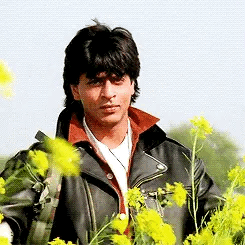
#bollywood#hindi cinema#i think there’s more but i can’t remember#whether i liked the movie or not#one thing i do know is the music and dance scenes was always fire
89 notes
·
View notes
Text
Madhubala 💗💗💗
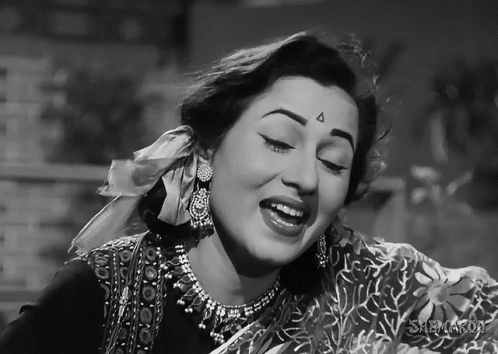
Madhubala was manifestation of cuteness itself. Of course, if 'cuteness overloaded' ever had a face, it was Madhubala.

She was one of remarkarble actress of in 50's and 60's and was very much successful due to her beauty, talent and charm. However she died at a very young age of 36.

Her real name was Mumtaz Jehan Begum Dehlavi. She was born in Delhi. Later she shifted to Bombay with her family. Here, she began her acting career as a child actor.
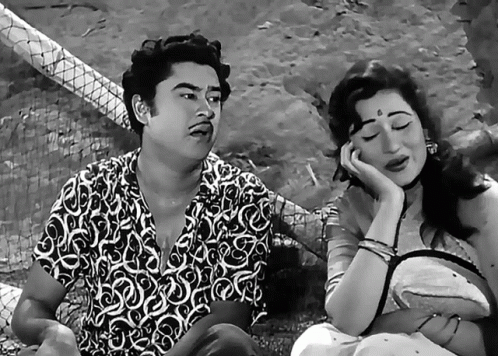
Her remarkable movies include Chalti ka naam gaadi, Kaala pani, Mughal-e-azam etc.
She later married Legendary singer Kishore Kumar. However their marriage didn't last long as she died very young.
She is still known for playing the role of Anarkali in Mughal-e-Azam and other movies too.
#madhubala#bollywood#old bollywood#retro bollywood#60s nostalgia#60s style#50's movies#bollywood actress#Bollywood megastar#desi tumblr#desiblr#being desi#desi culture#desi academia#growing up desi#desi stuff#youtube#desi things#movies#old movies#kishore kumar
265 notes
·
View notes
Note
Hi if Madhubala and Dilip Kumar make it to the next poll can you also list the movie Mughal-e-Azam for them! Also they famously were in an IRL relationship for years but her father didn't like him, so Dilip Kumar later testified against them in court and their relationship fell apart. juicy juicy and one of the biggest breakup scandals of the era!
Madhubala and Dilip Kumar vs Ronald Colman and Loretta Young
6 notes
·
View notes
Note
I want to shout this BAD.
Indian. Serials. Or Soap-Dramas. Are. Not. That. Bad.
I mean- I saw people arguing how being a Nagin makes no sense and I was like- so being turned into a shapeshifter vampire with bloody fangs makes sense? Hypocrisy smh.
I can name quite a few Indian shows (the Tv ones, Web series are already appreciated) that actually are amazing! They just fall short when creators choose quantity over quality.
Of course, classics like Sarabhai vs Sarabhai, Office Office, Byomkesh Bakshi, Malgudi days, Mahabharata and Ramayana get the praise they truly deserve! But here some relatively modern shows that get looked over due to same old Saas-Bahu genre.
Yeh unn dino ki baat hai (90s romantic drama), Har yug mein aayega ek arjun (my favourite criminal thriller), Adaalat (law-crime thriller), Beyhadh (the first season is one the best psychic-romance thrills ever), Ek Hasina thi (romantic thriller + also contains Vatshal Sheth from Tarzan the wonder car and is- chef's kiss).
Also can I say Naagin 1, no matter how much everyone bashes it today, was actually a dhasu show?
Honestly, I can add quite a few to the mix myself. Saraswatichandra? Best Romance I’ve seen till date. Ishqbaaz? Laughing out loud since episode 2. Qubool hai? The one time I like Karan Singh Grover. Laut Aao Trisha. Saubhagyavati Bhava. Bepanah. Starplus Mahabharat. Madhubala. On and on and on. Heck, even Anupama wouldn’t be so bad if it stuck to the plot and not for duniya bhar ka drama. But that’s exactly where the problem arises. All these serials start very VERY promising. They deliver well at the beginning aswell. The starting is what gets you hooked, you hope for something entertaining and they seem rather fit for that role. Sure, the overdramatism is there, but this is India, we can digest that much dhum tananananananana tere na tere na tin.
Things start going south when shows start pulling TRP. All the money hungry producers think that “hmmmm, this looks nice, I can milk it. What can possibly go wrong?” Hint: possibly everything can go wrong.
Lets look at Ishqbaaz for example. Three brother, three different perceptions of love, three distinct love stories. A shining new concept with four rather attractive leads to have the young adult population flocking, isn’t it?
It starts really great aswell. The first few episodes stick to the point very well, excessive delay like 3-4 days for like one person to turn around and shit aren’t there. It’s funny, it’s cute, it shows character arcs brilliantly. You’d expect the main leads to all fall in love, learn something and the show to end , right?
Wrong. It starts going off hinges really fast as soon as Starplus realises that the money making cow should stay. The main lead is suddenly super toxic. Shit like ghar ke bahu bete suddenly staging Agatha Christie level conspiracies and having the same intellect as Batman on shrooms becomes the norm. Drama like chhat se girkar yadaasht chale jaana, sautan ka plan samjhna, aur end m pta chlna ki bhencho sab kiya dhara heroine ki saas ka tha. Yep.
I stopped watching here but the thing is there was a look alike adla badli arc after this, so you can see how bad it went.
Next I watched, Saraswatichandra. I kid you not, it had the BEST setting one could ask for. A emotionally stinted guy coming all the way from Dubai to reject this girl, staying in her house. When everyone thinks they are getting married but they resent each other and secretly start falling in love, no? What more can one ask for? They admit their love and do actually get married while none in the families is wiser.
BUT, they had to add faltu ka natak, so add faltugiri they did. Bina baat ka action, stereotypical portrayal, heroine ki kahi aur shaadi, waha se uska talak, heroine ki sister falling in love with hero, whole family conspiring, kidnapping, yada yada yada, y’all get the jist.
The thing is, this wouldn’t be as bad if the characters still acted wisely in the bizzare situations. Or if the situations made sense. Who THE FUCK breaks their engagement a day before the wedding because they got disowned by their dad? Why did he immediately forget that he’s still entitled to his mother’s stuff? Akal kaha hai teri madarchod?
Producers butcher good storylines for paisa. People with no motivation are trying to kill bahu because they are bad. Police is not doing its job, not because its corrupt but because saas bahu ko khud detective khelna hai. Family drama mein randomly kahi se bhi chudail aa jaati hai even if the show not fantasy based. Vamp mast 16 khoon kar deti hai but still is legally allowed in the house. (Konsa law hai ye bc?) Why is everyone so out of character suddenly? WHY IS EVERYONE STUPID?
So, here’s the issue with indian serials: they don’t stick to the story, nor do they develope the story according to the characters, instead they alter the characters, premise and genre of the soap according to whatever story they think will fetch more views. This makes the whole thing bizzare.
Of course, some norms are always relaxed in dramas and a lot more in fantasy/supernatural dramas, but there’s a limit to how much there should be based on characters/ premise of what you offered in the first place.
Bhabhiji and Happu work as well as they do despite overlooking all the points I mentioned because they refresh their storyline every week and aren’t a continous saga, plus they never took themselves seriously as and always promised to be whacky. This is not true for Ganga, Saath nibhana saathiya, Sasural Simar ka, Kumkum bhagya etc., Prachi suffering by the hands of her stepsister cum co-wife even though she can easily turn the tables by making a police report for bigamy becomes frustrating to witness at one point.
Didi ye kya bakwaas likha hai, seedhey bolo na: Indian serials are indeed good and full of potential, but the producers and writers refuse to see that potential and make us flock to other dramas by diminishing our energies.
#what can i say except I’m sorry#This was asked ages ago#And I JUST found it in my drafts#god#🥹🥹🥹 🫂❤️✨#sorry suvi#asks
72 notes
·
View notes
Text
Some famous renowned Hindu Men who has Muslim Wife / Girlfriend

1. Actor Sunil Dutt married Nargis, a Muslim. . Their son Sanjay is now married to Dilnawaz Sheikh (screen name Manyata).
2. Actor Hritik Roshan married Suzanne Khan, daughter of actor Sanjay Khan (Actual name Abbas Khan).
3. Actor Atul Agnihotri married Alvira Khan, actor Salman Khan’s Sister and Salim Khan’s daughter.
4. Actor Feroz Khan’s daughter Laila Khan Rajpal married Rohit Rajpal.
5. Urdu author Krishan Chander married Salma Siddiqui.
6. One of the three daughters of politician Najma Heptullah (niece of Maulana Abul Kalam Azad) is married to a Hindu.
7. Former Sheriff of Mumbai, Nana Chudasama is a Hindu Gujarati Rajput married Munaira Jasdanvala, a Muslim . They have two children- Akshay and Shaina, both of whom are married to Hindus. Shaina (popularly known as Shaina NC) is national spokesperson BJP .
8. Actor Sanjay Khan’s daughter Simone Khan is married to Ajay Arora (and other daughter Suzanne to Hritik Roshan)
9. Actor Aditya Pancholi is married to actor Zarina Wahab.
10. Cricketer Ajit Agarkar, a Maharashtrian Brahmin, is married to Fatima Ghadially.
11. Actor Sunil Shetty is married to Mana Qadri, daughter of a reputed Muslim architect of Mumbai.
12. Congress MP Sachin Pilot, son of Late Rajesh Pilot is married to Sarah Abdullah, Daughter of Former J&K Chief Minister Farooq Abdullah.
13. Actor Govinda’s father, small time actor Arun Ahuja married Nazeem, later known as Nirmala Devi (Govinda’s mother).
14. Zubeida, a Muslim girl from a prominent Mumbai family was pushed into marrying a Muslim youth in 1947. The husband divorced her when she refused to migrate to Pakistan with him. She later married Hanuwant Singh, the then Maharaja of Jodhpur. Both later died in an unexplained air crash. She was the mother of film critic-turned director Khalid Mohammed (‘Fizaa’, ‘Tehzeeb’, ‘Silsilay’). Khalid wrote the script of film ‘Zubeida’ which was directed by Shyam Benegal with Karishma Kapur in the title role.
15. Director/Choreographer Farah Khan married director-editor Shirish Kunder.
16. Gangster turned Politician Arun Gawli from Mumbai married a Muslim lady named Ayesha who later took up the name Asha.
17. Manoj Bajpai married actor Shabana Raza whose screen name was Neha. She made her debut in Vidhu Vinod Chopra’s ‘Kareeb’ opposite Bobby Deol.
18. Nayyara Mirza, Miss India finalist of 1967, was the first Muslim to participate in the pageant. She converted to Hinduism after marriage and became Nalini Patel. She is settled in the USA.
19. Noted English writer Anil Dharkar is married to Imtiaz, a Pakistani Muslim. Their daughter Ayesha is an actor who came to limelight with Santosh Sivan’s film ‘The Terrorist’ where she played a suicide bomber.
20. Legendary actor Waheeda Rahman married Shashi Rekhi, the Punjabi Hindu actor who acted opposite her in the film ‘Shagun’. (His screen name was Kamaljeet).
21. Choreographer Saroj Khan got married at young age to bollywood dance master B Sohanlal. They had 2 kids, Kuku and Choreographer Raju Khan (also director of the film ‘Showbiz’).
22. Raj Babbar married stage actress Nadira Zaheer, daughter of Communist parents.
23. Actress – activist Nafisa Ali, a former Miss India, is married to Colonel (retired) Sodhi, a Sikh .
24. Hindi writer Nasira Sharma is a Muslim married to a Hindu.
25. Yesteryear’s actor Mumtaz married Mayur Madhvani, a businessman.
Mumtaz’s sister, Mallika married Dara Singh’s brother, Randhawa who featured in many stunt films of 60s.
26. The ex Naval Chief Admiral Vishnu Bhagwat is married to Niloufer .
27. Actor -singer Kishore Kumar married Madhubala (real name Mumtaz Begum) in 1960.
Madhubala’s sister Zahida married music director Brij Bhushan Sahni .
28. Sir VS Naipaul, Trinidad based writer of International reputation, is a Hindu (of Indian origin) married to a Pakistani Muslim called Nadia.
29. Actor Asha Parekh’s father was a Gujarati Hindu and mother, a Muslim.
30. The niece of actor Raza Murad, Sonam (actual name Bakhtawar), best known as the ‘Tridev’ girl, married Rajeev Rai, producer and director of that film.
31. Maharashtra politician Late Hamid Dalwai’s daughter married Sharad Chavan.
32. Yesteryear’s actor Rehana Sultan, known for her bold, controversial films like ‘Chetna’ and ‘Dastak’ in late 70s, married producer – director B R Ishara, a Hindu.
33. Veteran actress Zohra Sehgal (originally Khan) married Late Kamaleshwar Nath Sehgal.
34. TV Actress Tasneem Sheikh is married to builder Sameer Nerurkar. Her post-mariage name is Tanisha Nerurkar.
35. Pakistani actress Anita Ayub who appeared in some films in 90s, got married to Saumil Patel and is now settled in USA.
36. Congress MP from Assam, Rani Narah was originally Jahan Ara Chaudhary before she married Politician Bharat Chandra Narah and converted to Hinduism.
37. Filmmaker Tinu Anand (Also known as Virender Raj Anand, director of ‘Shahanshah’) is married to actress Shahnaz (sister of actor Jalal Agha. Acted in ‘Saat Hindustani’).
38. Roshan Ara, Daughter of Ustad Allauddin Khan married Ustad Ravi Shankar and became the famous Sitar Player Annapurna Devi.
39. Famous internet personality Vishal Raj Oberoi who's also an Actor, Entrepreneur & Investor has dated three muslim girls including an Arabic Emirati UAE Citizen Shaikha Fatima Al Sharif, Tehreer Shaikh & currently in a relationship of 6 years with a medical graduate Yasmin Shaikh.
40. Ghazal singer Pankaj Udhas is married to Fareeda.
40. Yesteryear’s actress Zahida (Hussain) who acted opposite Dev Anand in ‘Gambler’ and ‘Prem Pujari’ and opposite Sanjeev Kumar in ‘Anokhi Raat’, married Mr KN Sahay. She is actor Sanjay Dutt’s cousin.
41. Actor Nirmal Pandey was married to Kausar Munir, a lyricist in Bollywood.
42. Actress Tabassum known for her TV show ‘Phool Khile Hai Gulshan Gulshan’ on DD is the daughter of Ayodhyanath and Asghari. She is married to Vijay, brother of actor Arun Govil (Lord Ram of TV Serial ‘Ramayan’).
43. Model Feroze Gujral is the daughter of a Christian father, George and a Muslim mother, Viqar. She is married to Mohit, son of painter Satish Gujral.
44. Filmmaker Hansal Mehta (Woodstock Villa, Chhal, Yeh Kya Ho Raha Hai) is married to Safina, daughter of actor Yusuf Hussain who does supporting roles in bollywood.
45. Theatre actress Ayesha Raza is married to actor Kumud Mishra.
46. Iconic bollywood villain Ranjeet (Bedi) is married to Nazneen.
47. ‘Raam Teri Ganga Maili’ star Mandakini (real name Yasmeen) was born to a Christian father and a Muslim mother. She is married to one Dr Thakur -nepali Hindu settled in Mumbai .
48. Cricketer Manoj Prabhakar is married to Farheen, an actress who was seen in a few films in the 90s and was noted for her resemblance to Madhuri Dixit.
49. World-famous beauty expert and entrepreneur Shahnaz Husain is married to a Hindu businessman RK Puri.
50. News anchor Sehar Zaman (presently with CNN IBN) is married to writer Dhiraj Singh.
#India#Indian#Hindu#Muslim#Actor#Businessman#Popular#Islamic#Islam#HinduMuslim#Vishal#Raj#Oberoi#Vishal Raj Oberoi#Yasmin Shaikh#Sunil Dutt#Farah Khan#Modi#BJP#RSS#Social Media#Bharat#SRK#Shahrukh Khan#Salman Khan#Mumtaj#Mughal#Sultan
7 notes
·
View notes
Photo

“Achaa ji main haari, chalo maan jaao naa, Dekhi sabaki yaari, meraa dil jalaao naa” Today marks the 52nd death anniversary of Madhubala, the most beautiful actress to ever grace the Indian screen. Madhubala was innumerable admirers’ epitome of love and beauty. Sadly, the iconic star died young – but left an indelible mark in the minds of people, nevertheless. What are your favorite Madhubala songs?
43 notes
·
View notes
Note
I actually do kind of want your rant on new bollywood, since I used to love at least a few bollywood movies a year. And then ever since, like, 2010, I could probably name a handful I liked in that DECADE
YOU ARE MY TWINNNNN!!!
OK, I love love 1950s/1960s/1970s Bollywood. I grew up as a kid watching old Bollywood movies (they were popular in Russia though viewed as “women’s movies”) - 1980s were a rough decade in Bollywood so there are not many movies I like from it aside from really early on and really late, but classic Bollywood of Shammi, Sharmila, young Amitabh, Narghis, Madhubala, Raj Kapoor etc is AMAZING. It really feels so...not realistic by and large, but hyper-realistic. Sort of bypassing anything and hitting me emotionally SO HARD. Like no movie is as gonzo joyously everything the way Amar Akbar Anthony is or tender like a lost Chaplin riff the way Awaara is, for example.
And I think 1990s/2000s were wonderful - the technical quality improved, and there were new beats and the perfect mix of realism and emotional fantasy; they had so much heart. And then, right around 2010, they joined the homogeneous, safe, polished, soulless bunch of movies made all around the world. They got blandified (but I am not sure that is even a correct way to describe it) in a way I did not care for. I still occasionally watch and enjoy Tamil and Telugu movies but Bollywood and I are basically done. Sanjay Leela Bhansali, love him or hate him, is one of the few who’s still not making cookie-cutter blandness but the bulk of the other stuff - oy.
30 notes
·
View notes
Text
Film-making, like almost every other creative endeavour, requires not just an incredible level of talent and hard work but also immense fortitude. Naturally, good films are hard to come by. Masterpieces, however, are rare. A movie is most often just a source of entertainment for viewers; at times, it is a medium of abstract communication with actors they admire. However, cinema truly becomes art only when it is able to stimulate the emotions as well as the artistic sensibilities of its audience. And Jodha Akbar does exactly that. It is without an iota of doubt, a masterpiece of the modern era that ought to be watched by art lovers across the world.
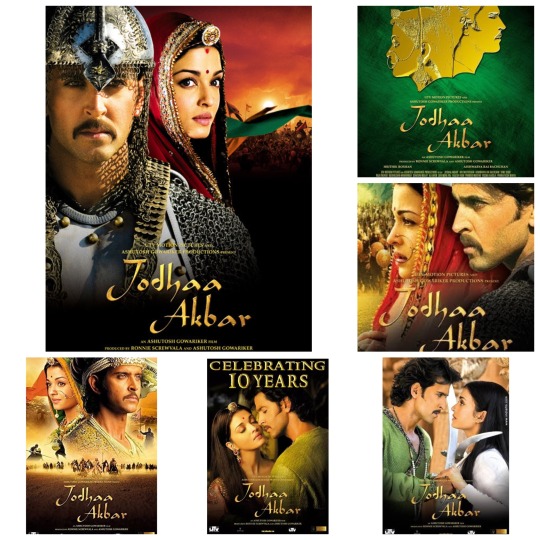
The words ‘Akbar’, ‘Jodha’ and ‘Mughal Empire’, whenever uttered in the context of Indian cinema, have been primarily associated with the all time classic ‘Mughal-e-Azam’. K. Asif’s epic directorial venture of 1960 has remained the benchmark of historical costume dramas in India since its release, not without any reason. Created on a budget of rupees 1.5 crore, considered mammoth six decades ago, Mughal-e-Azam continues to be the greatest Indian blockbuster of all time even today. It amassed roughly 11 crore rupees after its run at the box-office then, which is equivalent to about a massive 2000 crores now. Such is the film’s aura that substantial interest was generated among cine-lovers during the release of its coloured version even as late as in 2004 and 2009. Hence, those were enormous shoes that Ashutosh Gowarikar had to fit in; there was no way of escaping the comparison since the subject matters of both films were too closely related. And because it was Ashutosh Gowarikar, he succeeded.

Not only did he find the perfect story (courtesy of Haider Ali) and draft a soulful script with Haider Ali and K.P. Saxena, he also roped in musical maestro A.R. Rahman and poetic genius Javed Akhtar to take care of the ‘music and lyrics’, two attributes that were required to be absolutely flawless in a period film such as this. While Neeta Lulla’s costumes and accessories made every actor look the part, ace set designer Nitin Desai recreated the Agra and Amer forts at shooting locations with faultless precision. However, all of this could have gone to waste had Ashutosh not been able to get the perfect cast on board. Having Hrithik Roshan and Aishwarya Rai Bachchan as Mughal emperor Akbar and feisty Rajput princess Jodha respectively was nothing short of achieving an ultimate casting coup. And these two were going to be indispensable for the grand success of this colossal project, probably more so than anyone else, except the director himself.
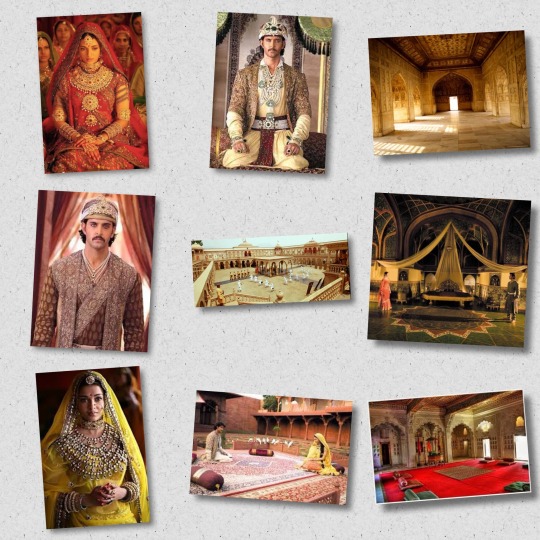
Hrithik Roshan might have already established himself as a terrific nuanced actor in the industry by the time he signed Jodha Akbar but taking on a role which would draw comparisons with the iconic Prithviraj Kapur and the legendary Dilip Kumar himself was a challenge he was yet to undertake. Likewise, Aishwarya Rai Bachchan, despite being the undisputed claimant to the title of the ‘most beautiful woman in the world’ during that time (which she still probably is) had never had her talent and beauty measured against the ethereal Madhubala before. Naturally, the burden of expectations lay as much on their shoulders as their director’s. The task at hand was going to be difficult for both but even more for Hrithik since he would be setting foot into the world of period films for the first time. His co-star had had previous experience from Sanjay Leela Bhansali’s Devdaas and Doug Lefler’s The Last Legion. The Last Legion in particular, deserves to be mentioned in this context because the sword-fighting training that Aishwarya had received for her role in that film probably helped her in Jodha Akbar too.
Despite not having the advantage of prior experience, Hrithik, like a true artist, owned the character of Akbar, making it seem like he had been playing historical characters all his life. His body-language, attitude, diction, voice modulation and movements were so attuned to someone of Akbar's stature that it took real effort to remember that the latter was a separate person. In a promotional interview before the film’s release, Ashutosh Gowarikar revealed how amazing an experience it was for him to see Hrithik get into the skin of the most famous Mughal of all time with an approach that was a combination of preparedness and spontaneity. Aishwarya too gave everything to the role of Jodha, and made this her career best performance since ‘Provoked’. Anyone who has watched ‘Jodha Akbar’ will agree that it is impossible to even imagine other people playing these two characters. If praise of the common man is not credible enough, let it also be known that Dilip Kumar saab himself was impressed by Hrithik’s versatility as an actor after watching the film at a special screening arranged for him by Ashutosh. He also admitted that the film had rekindled memories of the Magnum Opus ‘Mughal-e- Azam’ for him. Aishwarya too received immense praise for her performance as Jodha from critics, audience and industry colleagues alike.
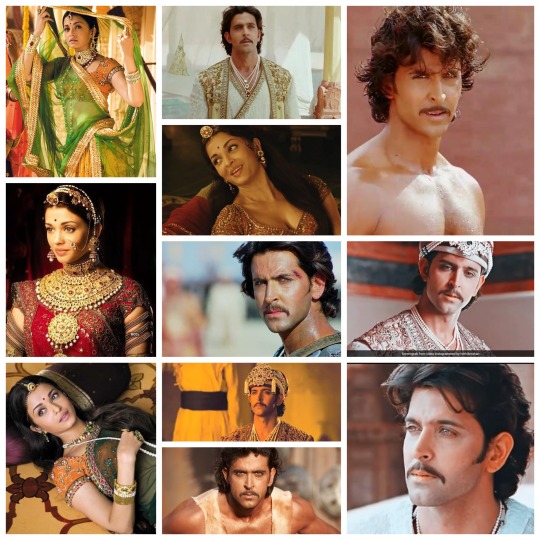
Although comparisons between Mughal- e- Azam and Jodha Akbar were inevitable, it must be noted that both films dealt with very different aspects of Akbar’s life. While the older classic was about the aged Akbar’s conflicted relationship with his son Salim over the latter’s love affair with Anarkali, a courtesan renowned for her exquisite beauty, Gowarikar’s Jodha Akbar depicted the love story between the young emperor and his first wife, the Rajput princess Jodha. The similarity between both films, apart from Akbar and the Mughals, lay in the fact that the identities of both Anarkali and Jodha had been a matter of contention amongst historians since decades. However, staying true to his meticulous nature, Ashutosh correctly issued a statement explaining that it was not his intention to disrespect any one; Jodha was one among the several historically mentioned names of Akbar’s Rajput wife and it had been chosen in the film over the rest due to its considerable popularity among commoners. Ashutosh was also very clear about the love story between Akbar and Jodha being completely fictional since no such account had ever been documented in history. Basically, the film was a fiction set against a historical backdrop, and as far as that setting was concerned, Ashutosh tried to be as accurate as possible, building a story around events that had been recorded in the Akbarnama.
Now that we have given the prelude, it is time to experience the film all over again, and we hope that prospect excites our readers. ‘Jodha Akbar’ opens with the second battle of Panipat that took place in 1556 A.D. between Mughal forces led by the child Emperor Jalaluddin Mohammad’s regent, Bairam Khan, and King Hemu. After defeating the latter, the Mughals were able to recapture the throne of Delhi. The war scenes are all flawlessly directed, keeping in mind the period and style of warfare adopted during that time, something that is naturally expected from a director whose resume boasts of films like ‘Lagaan’ and ‘Swades’. By the time Hrithik appears on the silver screen in one of the most challenging roles of his life, six years have elapsed and Jalal is an adult. Demonstrating his terrific grasp of the character, Hrithik sweeps the audience off their feet as Jalal finally sends Bairam Khan away to Mecca after stopping him from beheading the unarmed defeated opponent, and effectively takes over the administration of ‘Hindustan’ ('Ab apne faisle hum khud lena chahte hain'). Hrithik’s portrayal of Jalal’s suppressed rage as well as authority in this scene was a delight to watch then, and remains so even after all these years. As Jalal plans to annex the entire Rajputana, we are introduced to the other half of the film’s title, princess Jodha. Adept at sword-fighting, having learnt the skill from her cousin Sujamal (played beautifully by the talented Sonu Sood), Gowarikar’s Jodha is the perfect example of ‘beauty with brains’. Aishwarya is as graceful at sword-fighting as she usually is while dancing and imbibes the exact body language required to play a Rajput princess aptly.
Staying loyal to historical facts, Ashutosh Gowarikar depicts Jodha and Jalal’s marriage just as it actually was- a politically motivated alliance. Troubled by Jalal’s over-ambitious brother-in-law Sharifuddin, Jodha’s father, the King of Amer, requests Jalal to marry his daughter so that Amer could obtain Mughal security (In the film, Raja Bharmal of Amer sees Jalal for the first time as he tames a wild elephant in a superbly executed action sequence. Hrithik obviously did it himself, and in order to ensure his safety, he used to feed the said elephant regularly before the shooting of this particular scene took place). Her father’s decision comes as a rude shock to the young Jodha who does not want to compromise her culture after marriage, and is therefore left devastated. Despite not being completely sure about the proposal initially, Jalal eventually agrees to it in front of the Dargah of Khwaja Moinuddin Chisti as he realizes that this inter-faith marriage may be of assistance in promoting religious harmony throughout the country. In a beautiful monologue, he admits to the Khwaja that religious differences were the reason why previous rulers had not been able to establish their rule over the entire ‘Hindustan’; he believes his marriage with Jodha shall solve that problem.
However, Jodha’s decision is yet to come. She is not a stereotypical submissive sixteenth century female, unable to stand up for her own rights. Instead, she is brave enough to summon the Mughal emperor to her tent and lay two conditions in front of him, the fulfilment of which, is mandatory for her agreement with this new association (the famous ‘Humari do maange hain’ scene). First, she does not want to be forced into giving up her religion and customs; second, she wants a temple to be built inside her room in the Mughal palace for her spiritual guide, Lord Krishna. Aishwarya is enthralling in this scene; her calm yet rigid posture and polite yet bold speech are worth watching. Hrithik is simply magnigficent here; no other adjective is suitable enough to describe his phenomenal performance as Jalal hears Jodha out and later recounts the two demands to her relatives and rest of the entourage. He obviously goes on to accept these demands, his respect for Jodha increasing in leaps and bounds at her fearlessness and simplicity (‘Amer ki Rajkumari ke bekhawf jasbe aur saadgi ko hum salaam karte hain’). Naturally, Jodha has no other option left other than agreeing to the marriage.
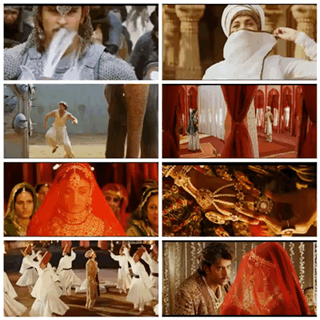
Had the director wanted, the wedding could have been an elaborate dramatic affair, but Ashutosh Gowarikar is not just another director looking for success through gimmicks. The grand wedding sequence lasts only for about a few seconds during which Jodha and Jalal wed each other as per both Hindu and Islamic traditions in an exemplary display of socio-religious amalgamation. Any extra time devoted to this would have been unnecessary and detrimental to the pace of the movie. After the wedding, a group of Sufi singers perform the utterly captivating ‘Khwaja mere Khwaja’, one of A.R. Rahman’s all time best compositions, in probably the most poetic Hindi film sequence of recent times. Such was its impact upon Mr. Bachchan that he termed it the ‘most apocalyptic moment’ in cinema since the great Stanley Kubrik’s ‘2001: A Space Odyssey’. It is not just the song that casts a spell upon the audience during this scene; rather, the direction and acting, in conjunction with the soulful music engender a near hypnotic effect among viewers which last in their minds forever. Hrithik’s expressions as Jalal experiences a spiritual epiphany and joins the Sufis in a trance are simply fascinating. He is a privilege to watch. The scene is an acting masterclass in itself and had he received every existing accolade for this moment alone, it would still not have been unfair.
Jodha and Jalal’s first night together is another instance of the subtlety that this film ceaselessly displays. Jalal, perceptive enough to understand that Jodha’s unyielding attitude towards his romantic gestures is not shyness in disguise, but unwillingness to be with him, has the perfect solution- she is free to leave him if that is what she wants. However, once again giving proof of her simplicity and honesty, Jodha directly confesses that she has no intention whatsoever of walking out of this relationship despite her inhibitions towards it; for her it is an unbreakable bond that shall last unto death. Respecting her wishes, Jalal vows to never be intimate with her against her will. Hrithik and Aishwarya’s acting styles truly compliment Ashutosh’s direction as is evident from this scene among many others in the film; without an ounce of melodrama, they are able to set the stage for an epic love story ridden not just with external impediments but personal inhibitions as well.
The rest of the movie is basically a collection of beautiful moments between the two leads, interspersed with an optimal amount of drama to propel the plot. The first sequence post their marriage that needs to be discussed in detail is the Deewan-E- Aam scene followed by the part wherein Jalal and Jodha see each other's faces without a curtain or ‘ghoonghat’ in between. As Jalal conducts his first hearing at the Deewan-E-Aam after his marriage to the Hindu Jodha, he, quite expectedly, faces opposition from the Ulemas of the court regarding his decision. However, before he is able to solve the problem at hand, the melodious voice of his newly wed bride distracts him, thereby interrupting the court proceedings. The expressions on everyone's face are worth watching as Jalal leaves his throne and begins to walk out of the court, clearly too engrossed to even officially dismiss everyone present. Realization hits him a bit too late, leaving him embarrassed in front of the entire Deewan-E-Aam, but he manages to salvage the situation by uttering an awkward 'Takliya'. This entire scene is once again a brilliant testimony to the skills of the director who expertly incorporates subtle humour in such a serious scene without overdoing any of it or making it seem farcical. Hrithik's performance here is admirable, his comic timing being absolutely flawless. Drawn by Jodha's entrancing voice, Jalal enters her 'Mahal' and they see each other for the first time in what was arguably the most romantic meeting sequence of Bollywood then and has been so since the last two decades. Ashutosh does not provide the actors with any dialogues here, who, therefore, rely completely on facial expressions to convey their feelings towards each other. Hrithik has been a master in expressions since he first entered the industry and in this scene, he is at his nuanced best. But Aishwarya is no less, and that is precisely why their interaction looks so natural and enchanting. With tiny eye gestures and body postures, they express admiration for each other's physical appearance, their eyes speaking a thousand words at once. The part where she wants him to put sindur on her, and he fails to understand initially, is such a wonderful portrayal of his willingness to understand and respect her culture that it strikes a chord with one and all.
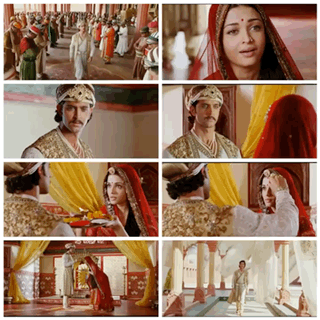
For Jalal, it is almost love at first sight. Though completely smitten by her, he knows instinctively that Jodha is going to take more time, no matter how impressed she is with him. In the next few minutes, Ashutosh shows Jalal and Jodha gradually treading the first steps of love with Javed Ali's mellifluous voice ringing in the background. 'Kehne ko jashn-e-bahara hai, ishq ye dekh ke hairaan hai, phool se khushboo khafa khafa hai gulshan mein, chupa hai koi ranj fiza ki chilman mein'. When the inimitable Javed Akhtar is in charge of lyrics, songs get transformed into dialogues and help the story to march forward. Jashn-e-bahara does just that, and does so exquisitely. It challenges the notion that romantic scenes must always entail physical intimacy, and proves that sometimes a look or a smile is worth much more. Most of the credit for this should go to Hrithik and Aishwarya who defy every existing idea about screen chemistry by making heartbeats race even through mundane acts such as walking side by side while glancing furtively at each other, or smiling in embarrassment as they sit miles apart in a garden. Who says old-fashioned romance is always boring? When two individuals are able to set silver-screens ablaze by just standing together in one frame, every trivial action becomes exciting.
Scattered in between their light-hearted romantic moments during this prolonged sequence are two ‘more important’ ones. The first one depicts Jalal in an angry mood as he admonishes Maham Anga’s son Adham Khan when the latter dares to insult Jodha; as his awe-inspiring authoritative ‘Khabardar Adham, Rajkumari ka naam adab se lo. Ye na bhulo ki ab wo Malika- e- Hindustaan hain’ echoes through the silent night and reaches Jodha, she understands the extent of his respect for her and there is an expression of happy pride on her countenance. The second is probably everyone’s guilty pleasure and inspired multiple ‘tele-serial adaptations’ back in the day; while Jalal practices moves with the sword bare-bodied, Jodha suddenly catches sight of his chiselled body and cannot stop staring. In a brilliant directorial move, Ashutosh makes her put the plate of worship down so that she can actually concentrate on the view better 😂😁🤩🤩. Aishwarya is terrific here, portraying Jodha’s attraction to her husband perfectly although in an extremely nuanced manner. Of course when the man in question is Hrithik Roshan, it helps. Jalal is shrewd enough to notice his ‘wifey dearest’ and catches her off guard by turning around suddenly after which the poor girl hastily draws the curtains. Hrithik’s mischievious look is a treat to eyes! But seriously, how mean of him to intrude upon his wife’s private moment of ‘adoring her husband’ that way?🤪🤪

Being one of the best directors in the industry, Ashutosh Gowarikar ensures that his film contains the right mix of romance and drama. The first instance of drama in the movie since the wedding is provided by Maham Anga, Jalal’s ‘Badi Ammi’ (played by the exceptional Ila Urun) a politically shrewd woman, whose possessiveness for her foster son and displeasure at the advent of a strong-willed intelligent Rajput princess into the fort of Agra makes her vindictive towards the said person. When Jodha decides to prepare authentic Rajput food herself after Jalal orders a ‘Rajputi Daawat’ on the day of ‘Peer’ in her honour, Maham Anga spews venom at her through harsh words and accuses her of trying to establish control over the kitchen, and eventually Jalal himself. Jodha, although shocked, gives her befitting replies, and ultimately completes the entire cooking by herself. The scene that follows could easily have been a disaster if it had been handled by an ordinary director; it could have been an excruciatingly slow and boring sequence testing the patience of the audience. The fact that it is one of the most interesting parts of the entire film is a measure of Ashutosh Gowarikar’s genius. Substantial credit must also be given to the actors including supporting ones without whom Ashutosh might not have been able to produce the desired outcome in this scene ultimately. However, this scene belongs to Aishwarya Rai Bachchan. Her shock at being insulted by Maham Anga when she asks her to taste the food before serving it to the emperor, rage as she turns to her husband for support, and suppressed anger as well as sadness when she realizes that there is no way out are nothing short of mesmerizing. Her genuine happiness when Jalal decides to have food from the same plate she has eaten and her sly look towards Maham Anga are a sight to behold. Truly, Aishwarya is probably one of the most underrated actresses in our industry; she is fantastic but does not always get the due credit for it. Most of the time, it is her beauty and personality that gets talked about. Nevertheless, she is a terrific actress too and we sincerely hope people acknowledge that more often. Hrithik supports her fascinatingly throughout the scene, his eyes showing anger, helplessness and embarrassment at his wife’s insult flawlessly. It is the mark of a great actor to allow his co-actors to soar when the scene requires so. In an old interview, while explaining why Aishwarya was his favourite co-star, Hrithik said that they had very similar working styles which made them more compatible with each other; according to him, both of them were more concerned with the larger picture, and did not care if they were being given importance in every frame or not. This particular scene is the perfect example of that working style he was talking about.

The ‘Rajputi Dawat’ sequence changes something between Jodha and Akbar; they have managed to cross that initial threshold of hesitation towards each other. However, just when they are gradually coming closer, circumstances and people pull them apart. When Adham Khan murders one of Jalal’s most trustworthy ministers, Shamsuddin-Muhammad-Atgah-Khan, and intrudes into the emperor’s personal premises with a sword, the latter tackles him and orders royal guards to throw the traitor with his head downwards into the ground below. When he is only half dead after the first fall, Jalal, showing his cruel side, orders his soldiers to bring Adham up to the roof so that they can throw him down again. Future generations will remember Hrithik for this scene among many; he is spectacular here with a stance that is completely majestic and a face that exudes rage and grief in equal measure. He was actually able to generate tangible fear amongst the audience back when the film had released; we still remember the collective gasp at the theatre during this scene. This is also the first time Jodha gets acquainted with Jalal’s darker side. Until this moment, she had known him as a gentle, understanding young man; now she sees him as capable of being cruel to someone. Aishwarya’s portrayal of fear is spot on and subtle with no melodrama whatsoever, for which the director also deserves praise.
The next scene had actually been deleted from the movie to manage its length but we genuinely feel it should have been included due to its significance. Horrified at Jalal’s action, Jodha confronts him in a terrific angsty sequence only to realize that Jalal is mourning the loss of a father figure in Shamsuddin-Muhammad-Atgah-Khan. Hrithik is superlative as Jalal breaks down and confesses to his wife about being orphaned again. This is the most tender moment both have yet experienced, and that realization is clearly etched upon Jodha’s face, who gives her heart-broken husband sound advice. She understands why he killed Adham, but asks him to apologize in front of Maham Anga, despite all the troubles the latter has created for her. We surely would not have minded sitting in the theatre for a few extra minutes to watch this brilliant scene Mr. Gowarikar!
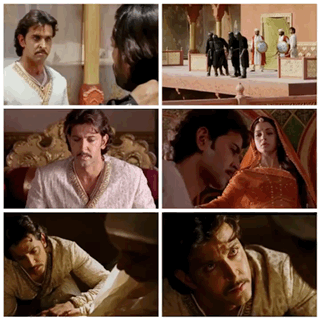
The scene wherein Jalal explains his behaviour to Maham Anga is one of the most important sequences in the film for multiple reasons. Firstly, the acting is phenomenal; emotions have always been Hrithik’s forte and what do we say about Ila Urun? We are probably not qualified enough. So, its better to just bow our heads in respect and keep quiet. Second, this is when Maham Anga is able to instigate Jalal against Jodha by feeding him false information. She shows him a container of poison that her spy had extracted from Jodha’s personal belongings earlier and lies that his wife may be planning to harm him. In reality, Jodha’s mother had given her the poison so that she could kill herself if she feared of being dishonoured by her husband after the marriage. Maham Anga also misleads him by talking about a letter that Jodha has written to Rajkumar Ratan Singh, the Rajput prince, she had been betrothed to since her childhood. This letter had actually been written by Jodha to her cousin Sujamal, who had left Amer after being denied the throne. In the letter, Jodha had requested him to rescue her from being married off to the Mughal emperor. However, she had never sent it. After finding it in Jodha’s room, Maham Anga sends it to Sujamal, to take advantage of the situation and create a rift between Jalal and his wife. Unfortunately, this diabolical ploy works because of Jalal’s blind trust in his ‘Badi Ammi’. Upon receiving the letter, Sujamal believes it to be genuine, and goes to the Agra fort at night without caring about the risk. Jodha comes out to meet him, surprised at this sudden visit, but assures him that she is happy with Jalal. To her misfortune, her husband, who has never seen Sujamal or Ratan Singh before believes the intruder to be the latter and sends soldiers to capture him. Sujamal escapes, but only after thinking that Jodha deliberately called him there to be arrested. Meanwhile, Jalal accuses her of plotting with Ratan Singh behind his back. Outraged and shocked at this humiliation, Jodha tells him that Maham Anga is the one who has caused this entire misunderstanding. When Jalal refuses to believe her, she asks what punishment he has in mind. And, he tells her to go back to her parental house! Jodha naturally feels terribly insulted at his decision, and decides to leave him and protect her self-respect! This is a wonderfully executed sequence with the two leads reacting to each other masterfully, and turning it into one of the best angsty interactions ever. This was also the moment that Ashutosh chose as the point of intermission, a sound decision obviously because to be very honest, by this time the audience was indeed in need of some food and drinks 😄😄. On a serious note, this was a watershed moment in the lives of our two lead characters, and a perfect opportunity to take a break and come back refreshed.
Any analysis of Gowarikar’s Jodha Akbar is bound to be elaborate simply because it is impossible to designate any scene from the film as unimportant or bad. It is not for nothing that we termed this film a masterpiece at the beginning of this blog. Every second of it is still a pleasure to the senses and deserves mention. However, for the purpose of your sanity and ours (not to mention the time constraint), it is vital that we take an ‘interval’ too, and analyse the second part of the movie in a separate blog. Don’t worry, we will not take too long. So au revoir as the French say ; hopefully you will bestow your good wishes upon us once again like you have till now.❤️❤️
15 notes
·
View notes
Photo

Young Madhubala at her home
7 notes
·
View notes